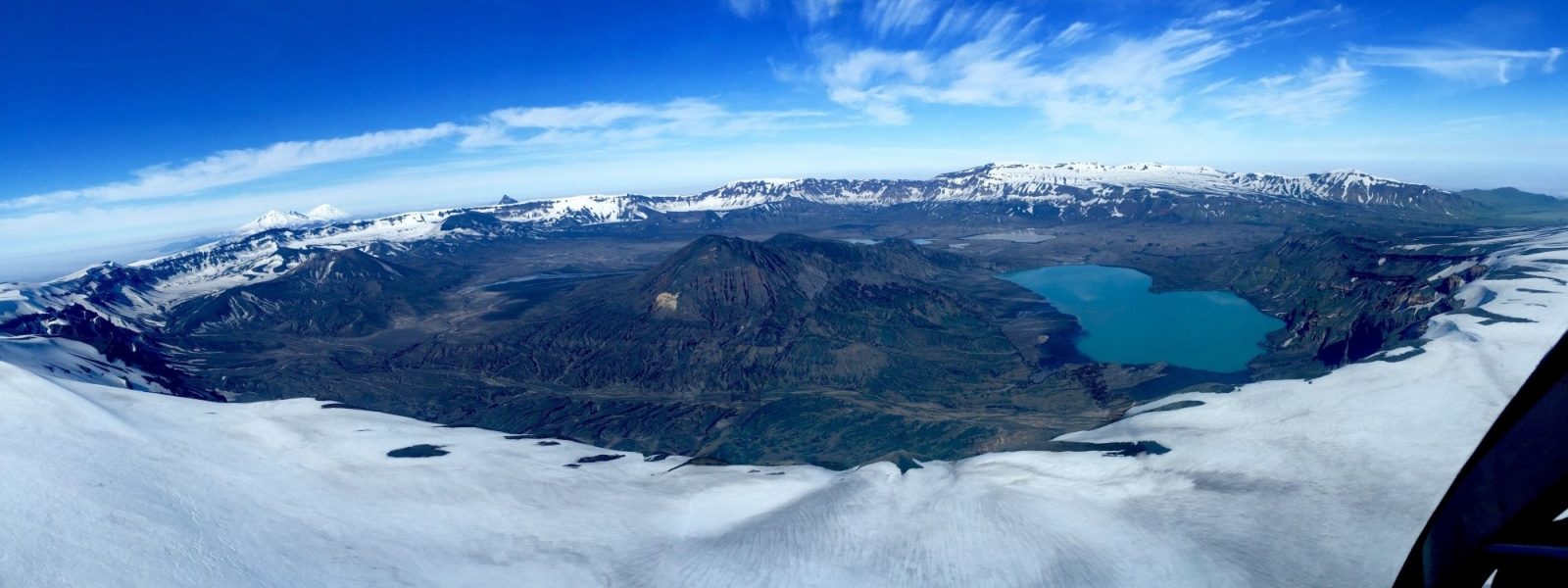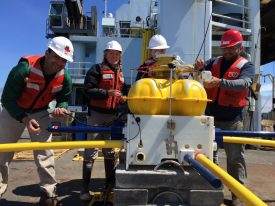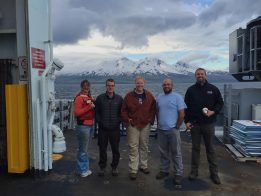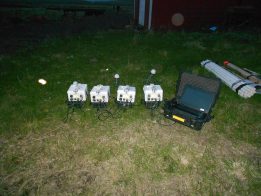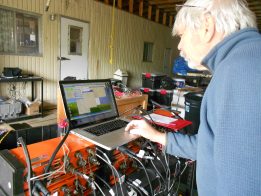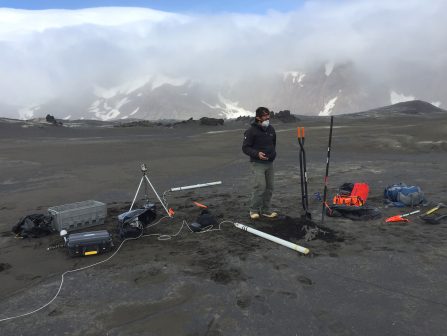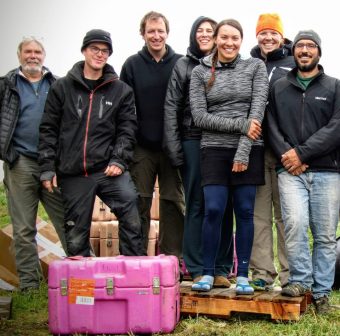Ninfa Bennington (U. Wisconsin-Madison), Kerry Key (Scripps Institution of Oceanography), and USGS Investigators Matthew Haney and Paul Bedrosian
Okmok is one of the most active volcanoes in the Aleutian arc and hosts a 10 km diameter caldera. The subdued topography of Okmok, relative to other Aleutian volcanoes, improves access and permits dense sampling of the volcanic edifice. We have selected Okmok as the site of study for this project due to frequent volcanic activity and the presence of a crustal magma reservoir as inferred from previous seismic studies. At least two caldera forming eruptions are recognized and Okmok is believed to be representative of volcanoes both within the Aleutian arc and worldwide, where long periods of effusive eruptions are punctuated by much larger explosive caldera forming eruptions.
We are applying geophysical techniques to characterize the magmatic system beneath Okmok. During the summer of 2015, we collected onshore and offshore magnetotelluric (MT) data and installed a temporary year long seismic deployment. The seismic instruments will be retrieved in summer 2016. These new geophysical data will be used to test hypotheses regarding the role of slab fluids in arc melt generation, melt migration within the crust, and the crustal magmatic plumbing and storage system beneath Okmok Caldera.
Offshore MT Field Deployment
After numerous delays due to thick fog typical of the Aleutians, the entirety of the offshore MT crew arrived to Dutch Harbor, AK and was assembled on the R/V Thompson. On June 18, 2015, the team departed Dutch Harbor for their first offshore MT site. The offshore crew spent the day preparing receivers so that there were only a few remaining steps to complete before deploying them over the side of the ship. By June 20, all 54 MT receivers had been deployed well ahead of schedule.
With the MT deployment complete, the team collected multi-beam bathymetry data on the upper forearc slope south of Umnak Island using the ship’s EM302 multi-beam echo sounder. On top of mapping the bathymetry of the ocean floor, the intensity of these recordings can be used to help determine the nature of the seabed (e.g. sediments versus hard rock). On June 21, the offshore team transited back to Dutch Harbor via Umnak pass. This return route included spectacular views of Mount Makushin Volcano on Unalaska Island.
Onshore MT and Seismic Deployments
On June 23, having returning to Dutch Harbor from offshore MT work, co-PI Key and Scripps graduate student Georgiana Zelenak joined up with the rest of the onshore team (PI Bennington, UW-Madison post-doc Summer Ohlendorf, and USGS collaborators Matthew Haney and Paul Bedrosian) and departed for Umnak Island. The onshore work was based out of Bering Pacific Ranch at Fort Glenn, an abandoned WWII military base, with a helicopter transporting the seismic and MT teams and equipment during the 19 days of field operations.
After the team arrived at Fort Glenn, the camp house was set up and seismic and MT equipment were prepared for the start of field operations the following day. Seismic and MT field operations commenced on June 23 and extended until July 11. The seismic team installed thirteen temporary broadband seismometers both in and around the Okmok Caldera. In tandem with the Alaska Volcano Observatory’s twelve permanent seismic stations, there are now twelve seismic instruments within or at the rim of the caldera and 14 seismic instruments outside the caldera. The temporary array will record seismic data until its retrieval in summer 2016. Onshore magnetotelluric data were collected in a 3D array using a combination of long-period and wide-band MT systems, with 19 stations within the caldera and ten stations outside. Following the completion of onshore fieldwork, part of the onshore team (PI Bennington, Summer Ohlendorf, and USGS collaborators Matthew Haney and Paul Bedrosian) caught a charter flight back to Dutch Harbor. Co-PI Kerry Key and graduate student Georgie Zelenak hitched a more unconventional ride when the rescue boat from the RV Sikuliaq picked them up from Umnak Island.
Offshore MT Instrument Recovery
Following completion of onshore MT work, the offshore MT team made a six day cruise on the new R/V Sikuliaq to recover offshore MT instruments. Of the 54 offshore deployments, 53 instruments were successfully recovered while one instrument was lost in Umnak pass due to strong tidal currents in the shallow water. ■
“Report from the Field” was designed to inform the community of real-time, exciting GeoPRISMS -related research. Through this report, the authors expose the excitement, trials, and opportunities to conduct fieldwork, as well as the challenges they may have experienced by deploying research activities in unique geological settings. If you would like to contribute to this series and share your experience on the field, please contact the GeoPRISMS Office at info@geoprisms.nineplanetsllc.com. This opportunity is open to anyone engaged in GeoPRISMS research, from senior researchers to undergraduate students.
We hope to hear from you!

